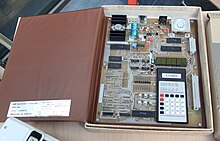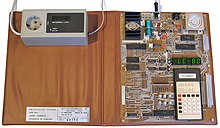LC80
| LC80 | |
|---|---|

|
|
| Manufacturer |
|
| Type | Learning computer |
| publication | Mid-1984 |
| End of production | approx. 1986/87 |
| Factory price | 720.00 M (without power supply) |
| processor | U880 @ 0.9 MHz |
| random access memory | 1 KB |
| graphic | 6-digit 7-segment display |
| Sound | Buzzer |
| Disk | Cassette, ROM |
| operating system | LC 80.1 |
The learning computer LC80 was a single-board computer made in the GDR and intended for teaching purposes.
History and Development
The LC 80 was developed from 1983 in the Microelectronics Advice and Information Center in Erfurt by a collective of developers. At the spring fair in 1984 it was presented to the public. A little later it was on the market, making it the first computer in the GDR that the population could buy.
“The LC 80 learning computer was developed by a collective from the Microelectronics Advisory and Information Center in the Erfurt district in cooperation with the consumer goods department of VEB Mikroelektronik“ Karl Marx ”Erfurt in a very short period of time. It was designed in such a way that a device that is as inexpensive as possible is made available to a wide range of users, which enables the practical use of microprocessor technology. High school and vocational school students, students specializing in electrical engineering / electronics, BMSR technicians and other interested parties can be considered as users. The LC 80 offers an almost unlimited field of application, ranging from hobby, school, training and further education to use for small industrial controls. "
Production probably ended around 1986/87.
export
The development of an export variant was initiated, possibly through an inquiry from NSW (Great Britain). This differed from the conventional LC80 in the following points:
- Wooden cabinet
- 12 KB ROM
- 4 KB RAM
- Keyboard template for chess program SC-80 (similar to SC2 )
This variant was probably never produced in series.
hardware
It was programmed by entering hexadecimal machine codes using a built-in pocket calculator keyboard. Saving and loading was possible via cassette or EPROM.
Further key technical data of the LC80
- Keyboard: 25 digits (16 hexadecimal, 9 function keys)
- optional input / output:
- Magnetic tape interface
- 12 programmable inputs / outputs, 4 handshake lines and 7 CTC lines
- CPU- BUS (unbuffered)
- Operating voltage: 8.5… 12 V AC / 10… 13 V DC
equipment
There were also accessories to buy such as:
- power adapter
- IC tester
- Datasette or cassette recorder
software
Except for the operating system, no software was included in the scope of delivery. Listings were only occasionally printed in the manual and in relevant magazines such as rfe , Funkamateur etc. There were circuit testers, games, synthesizers, Morse code programs, and more. An (integrated) chess program was even provided for the planned export.
Web links
- Homepage about the LC80, Z9001 (KC85 / 1), KC87 and Z1013
- LC80 on robotrontechnik.de
- LC80 on homecomputermuseum.de. Archived from the original on April 6, 2016 ; Retrieved April 6, 2016 .

